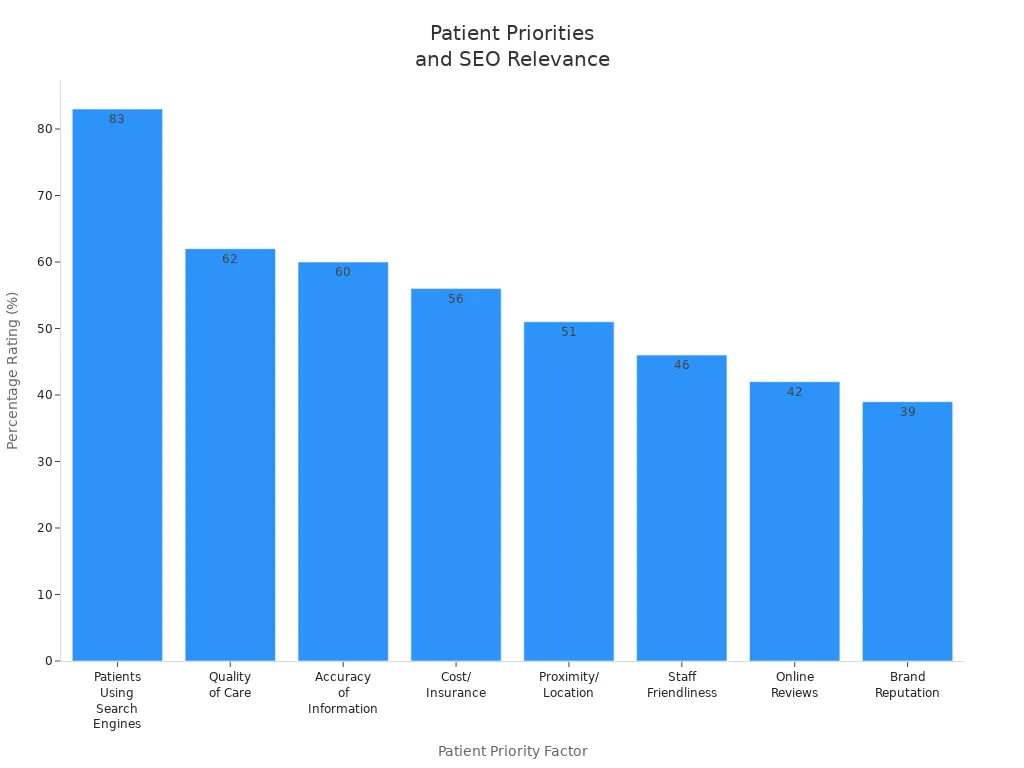Unlocking SEO ROI for Local Doctor Practices

Understanding and tracking SEO ROI has become essential for local healthcare practices aiming to boost revenue and attract more patients. Recent data shows that 77% of patients search online before booking appointments, highlighting the powerful connection between SEO and patient acquisition. Many healthcare providers have reported measurable success, with increased website traffic and patient inquiries soon after implementing SEO strategies. The following chart shows how patient priorities align with local SEO efforts, directly impacting revenue and long-term success:

Practices that focus on tracking the right metrics position themselves for sustainable growth and improved patient outcomes.
SEO ROI Overview

SEO ROI Defined
SEO ROI measures the financial return a local doctor practice gains from its search engine optimization efforts. This calculation helps practices understand how much value their SEO strategies bring compared to the money spent. Healthcare organizations often use several methods to track this value:
- Monthly website visitors, tracked with tools like Google Analytics, show how SEO increases traffic.
- Cost per lead, found by dividing total marketing costs by the number of leads, reveals how efficiently SEO generates new patient inquiries.
- Customer lifetime value estimates the total profit from each patient over time, highlighting the long-term impact of SEO.
- Comparing total marketing costs to the revenue and leads generated by SEO helps practices see if their investment pays off.
Tracking these metrics allows practices to adjust their strategies and focus on what works best.
Why ROI Matters
Understanding ROI is vital for local doctor practices investing in SEO. Measuring ROI helps practices make smart decisions about where to spend their marketing budget. The table below compares SEO with other marketing channels, such as Google Ads:
| Aspect | SEO Benefits for Local Doctor Practices | Comparison to Other Channels (e.g., Google Ads) |
|---|---|---|
| ROI Magnitude | High long-term ROI (5x to 12x) due to patient LTV | Immediate but short-term ROI, needs ongoing spend |
| Growth Pattern | Sustainable growth over years, no ongoing ad costs | Quick traffic, ROI plateaus without continued spending |
| Patient Value | High LTV from repeat visits and referrals | Focus on immediate conversions, less on retention |
| Cost Efficiency | Lowers acquisition cost as organic leads grow | Costs stay the same or rise with more ad spend |
| Trust & Authority | Builds trust through organic rankings | Paid ads less trusted, lower engagement |
| KPI Tracking | Tracks traffic, conversions, CAC, and LTV | Focuses on clicks and conversions, less on long-term |
| Competitive Advantage | Essential for healthcare due to strict standards | Paid ads costly and less sustainable |
Tracking SEO ROI also helps practices follow strict healthcare regulations and meet Google’s high standards for medical content. By monitoring key performance indicators like keyword rankings, traffic, and conversions, practices can improve patient acquisition and build trust in their community. This approach leads to better marketing decisions and long-term growth.
Measuring SEO ROI
Key Metrics
Local doctor practices rely on clear metrics to evaluate the impact of search engine optimization. Measuring SEO ROI starts with identifying the right data points. These metrics help practices understand how SEO efforts translate into patient growth and revenue generated from organic search.
- Organic search traffic: Tracks the number of visitors arriving from unpaid search results. This metric shows how well SEO strategies attract potential patients.
- Keyword rankings: Measures how the website ranks for targeted local medical terms. Higher rankings increase visibility and drive more organic search traffic.
- Click-through rate (CTR): Indicates the percentage of users who click on the practice’s listing in search results. A higher CTR means the content and metadata appeal to searchers.
- Conversion rates: Calculates the percentage of visitors who complete actions such as booking appointments or submitting forms. High conversions signal effective SEO and website design.
- Patient bookings: Counts the number of appointments scheduled through the website. This metric directly links SEO to patient acquisition.
- Revenue generated from organic search: Measures the total revenue from patients who found the practice through organic search traffic.
- Online reviews and ratings: Reflects patient satisfaction and trust, which influence both rankings and conversions.
- Local listings accuracy: Ensures the practice’s information is consistent across directories, supporting local SEO.
- User engagement metrics: Includes bounce rate, time on page, and pages per session. These numbers show how visitors interact with the site.
- Average page load time: Fast-loading pages improve user experience and support higher rankings.
Tip: Regularly tracking these SEO success metrics helps practices spot trends, identify strengths, and address weaknesses in their search engine optimization campaigns.
A table of typical healthcare benchmarks provides context for measuring ROI:
| Metric | Benchmark Range / Value |
|---|---|
| Conversion Rate (CVR) | 10-15% |
| Patient Acquisition Cost (CAC) | $300 - $1,000 |
| Cost Per Lead (CPL) | $26 - $50 (top players ~$30) |
| Click-Through Rate (CTR) | ~3.27% (medical PPC) |
| Patient Booking Online | 10% of patients book online |
These benchmarks guide practices in setting realistic goals for conversions, patient bookings, and revenue generated from organic search.
Measuring Success
Measuring SEO ROI requires a structured approach. Practices must connect SEO activities to real business outcomes, such as new patients and increased revenue.
-
Track key performance indicators (KPIs):
- Monitor new patient appointments scheduled through the website.
- Analyze conversion rates from different traffic sources.
- Review keyword rankings for targeted medical terms.
- Assess local search visibility within the service area.
- Evaluate patient engagement with website content.
- Check website bounce rates and average time spent on pages.
-
Analyze the data:
Regularly review the collected information to identify underperforming areas. For example, if organic search traffic increases but conversions remain low, the practice may need to improve website content or booking processes. -
Adjust strategies:
Update or expand content that does not perform well. Improve page load speeds on high-bounce pages. Add detailed information to popular service pages. Create new content based on emerging healthcare search trends. Optimize pages with refreshed keywords and information. -
Conduct quarterly SEO audits:
These audits help practices adapt to changes in search engine algorithms, patient behavior, and the competitive landscape.
The SEO ROI Formula
The industry-standard formula for measuring ROI in healthcare is:
SEO ROI (%) = ((Revenue from SEO - SEO Costs) / SEO Costs) × 100
This formula compares the revenue generated from organic search to the total investment in SEO. For example, if a practice spends $1,000 on SEO and earns $5,000 in revenue from organic search traffic, the SEO ROI is 400%.
Note: Specialized SEO ROI calculators for healthcare can simplify this process. These tools integrate data from website analytics, call tracking, and CRM systems to attribute conversions and revenue accurately.
Measuring ROI also involves tracking cost per acquisition, patient lifetime value, and return on SEO investment. Practices that focus on these metrics gain a clear view of how search engine optimization drives patient growth and revenue.
By measuring SEO ROI with these methods, local doctor practices can make informed decisions, optimize their strategies, and achieve lasting success in a competitive healthcare market.
Tools for Measuring ROI

Google Analytics
Google Analytics 4 (GA4) gives local doctor practices a powerful way to track patient acquisition and revenue from SEO. GA4 provides detailed reports that show how patients find the website, whether through organic search, direct visits, or referrals. These reports help practices see which channels drive the most patient visits and which pages lead to bookings. GA4 tracks important metrics such as sessions, users, bounce rate, and conversion rate. By monitoring these numbers, practices can measure how well their SEO strategies turn visitors into patients. GA4 also supports cross-platform tracking, allowing practices to follow patient journeys across devices. Linking GA4 with Google Search Console helps track search rankings and keyword performance. Practices should set up conversion tracking for actions like appointment bookings to connect SEO efforts directly to revenue.
Tip: Always maintain HIPAA compliance when configuring analytics to protect patient privacy.
Google Search Console
Google Search Console helps healthcare providers monitor SEO performance and search rankings. This free tool shows which keywords bring visitors to the website and highlights technical issues that may affect visibility. Providers can see which pages generate the most inquiries and track changes in local search rankings over time. Search Console also identifies errors that could lower rankings, such as broken links or mobile usability problems. By reviewing this data, practices can adjust their SEO strategies to improve local visibility and attract more patients.
Local SEO Tools
Local SEO tools like BrightLocal and Moz Local offer advanced tracking for rankings and business listings. BrightLocal provides detailed local rank tracking across Google, Bing, and directories, making it easier to monitor search rankings for multiple locations. It also features a dashboard for managing online reviews and tracking patient engagement. Moz Local automates listing management and helps keep business information accurate across directories. The table below compares key features:
| Feature | BrightLocal | Moz Local |
|---|---|---|
| Local Rank Tracking | Detailed, multi-location | Basic |
| Business Listings | Manual, precise control | Automated syncing |
| Review Management | Centralized dashboard | Automated alerts |
| GBP Management | Detailed insights, post scheduling | Integrated in dashboard |
| Pricing | Flexible, more features per dollar | Subscription, automation-focused |
These tools help practices track rankings, manage reviews, and measure the impact of local SEO on patient growth and revenue.
Calculating ROI
ROI Formula
Measuring SEO ROI helps local doctor practices understand the value of their marketing investment. The standard formula for calculating ROI is:
SEO ROI (%) = ((Revenue from SEO - SEO Costs) / SEO Costs) × 100
This formula shows how much income comes from SEO compared to the money spent. In a medical setting, measuring SEO ROI can be complex. Practices often have longer sales cycles and must assign values to patient leads. To measure revenue, practices use metrics like Customer Lifetime Value (CLV) and lead conversion rates. Costs include staff time, agency fees, SEO tools, and content creation. By tracking these numbers, practices can calculate ROI and see if their SEO strategies work.
Note: Assigning accurate values to leads and conversions is important for measuring ROI in healthcare. Practices should review their patient data and update values as needed.
ROI Example
Consider a local doctor practice that spends $2,000 per month on SEO. This includes in-house staff, an agency, and tools. Over one month, the practice gains 20 new patients from organic search. Each patient brings in an average of $500 in revenue. The total revenue from SEO is $10,000.
To calculate ROI:
- Subtract SEO costs from revenue: $10,000 - $2,000 = $8,000
- Divide by SEO costs: $8,000 / $2,000 = 4
- Multiply by 100 to get a percentage: 4 × 100 = 400%
The SEO ROI for this month is 400%. This means the practice earned four times what it spent on SEO. By measuring SEO ROI each month, practices can track progress and adjust strategies. Analyzing the ROI helps identify which efforts bring the most value and where to invest next.
Maximizing SEO ROI
Google Business Profile
A well-optimized Google Business Profile stands as a cornerstone for maximizing SEO ROI in local healthcare. Local doctor practices should ensure their profile displays accurate contact information, clinic hours, and a current website link. Adding service listings and high-quality photos increases the profile’s appeal and helps attract more patients. Responding to patient reviews and updating information regularly builds patient trust and credibility. Clinics with higher star ratings often see better rankings on Google Maps and search results, which can increase click-through rates by up to 35%. Managing reviews across platforms like Google, Healthgrades, and Facebook broadens reach and reinforces legitimacy. Automating review requests and responses helps maintain a consistent online presence, supporting sustained SEO benefits. Practices that update your local listings and keep information consistent across directories see improved local search visibility and higher conversions.
Tip: Encourage satisfied patients to leave reviews and respond to all feedback to show commitment to patient care.
Local Keywords
Targeting local keywords remains essential for maximizing SEO ROI and driving patient growth. Practices should conduct thorough keyword research using tools like Google Keyword Planner to find high-demand, location-specific phrases. Combining medical specialties with geographic identifiers, such as “pediatrician in Austin,” helps attract patients searching for nearby services. Incorporating these keywords naturally into website content, meta tags, and headings increases the likelihood of appearing in local search results. Using long-tail keywords, like “allergy testing for children in Dallas,” targets lower competition phrases that often lead to higher conversions. Setting up dashboards to monitor website visits, click-through rates, and bounce rates allows practices to refine their keyword strategy and boost your roi. Consistent use of local keywords helps healthcare providers appear in more searches, attract targeted traffic, and achieve local business triumph.
Note: Regularly review keyword performance and update content to stay ahead of changing search trends.
Website Experience
A seamless website experience directly impacts patient engagement, conversions, and overall SEO ROI. Easy navigation and clear information help patients find what they need quickly, reducing bounce rates and improving search engine rankings. Fast page load speeds keep visitors engaged and increase the chances of booking appointments. Mobile optimization ensures accessibility for users on smartphones and tablets, which is crucial since over half of web traffic comes from mobile devices. High-quality, patient-focused content builds authority and trust, encouraging more patients to choose the practice. Integrating AI tools, such as chatbots for appointment scheduling, streamlines patient interactions and increases conversions. Monitoring analytics like organic traffic, bounce rate, and session duration enables data-driven improvements that support ongoing success.
| Website Experience Factor | Impact on Patient Engagement and SEO ROI |
|---|---|
| Website Usability | Helps patients find information quickly, increasing engagement and conversions. |
| Page Load Speed | Reduces bounce rates, keeps patients engaged, and improves SEO performance. |
| Mobile Optimization | Ensures accessibility, boosts rankings, and enhances patient experience. |
| Content Marketing | Builds trust and authority, attracts patients, and improves SEO visibility. |
| Analytics Monitoring | Enables data-driven improvements for maximizing SEO ROI. |
| AI and Automation Tools | Streamlines interactions, increases conversions, and supports patient retention. |
Patient Reviews
Patient reviews play a vital role in boosting SEO performance and maximizing SEO ROI for local doctor practices. About 80% of consumers trust online reviews as much as personal recommendations, making reviews a key factor in building patient trust. Regularly monitoring and responding to reviews demonstrates a commitment to patient satisfaction and helps maintain a positive reputation. Encouraging patients to leave feedback through multiple channels increases the volume of positive reviews, which enhances online reputation and local SEO rankings. Optimizing Google Business Profile and managing reviews across platforms improve visibility in local search results, driving more traffic and potential patients to the practice. Tracking the impact of these efforts through analytics and CRM systems links SEO activities to patient acquisition and revenue, providing clear evidence of ROI and success.
Callout: Claim and verify your Google Business Profile, add accurate details, upload quality photos, and actively manage reviews to enhance local SEO and attract more patients.
The Long-Term Benefits of SEO Over Traditional Advertising
SEO strategies offer lasting advantages compared to traditional advertising. While paid ads provide immediate visibility, their benefits end when the budget runs out. In contrast, search engine optimization builds sustained organic rankings and ongoing patient acquisition. SEO reduces reliance on expensive ads and delivers cost-effective marketing with lower ongoing costs. By attracting users actively searching for healthcare services, SEO brings in higher quality leads and increases conversions. Quality content and reputation management through SEO strengthen patient trust and authority. Mobile optimization and local SEO ensure practices remain competitive and accessible to patients searching on smartphones. Over time, these strategies drive continuous growth, higher revenue, and long-term success for local healthcare providers.
Tip: Combine continuous keyword optimization, regular website audits, and patient engagement strategies to maintain strong SEO performance and boost your roi year after year.
Overcoming Challenges
Attribution Issues
Local doctor practices often face difficulties in tracking the true impact of their seo strategies. Many struggle to determine which marketing efforts bring in new patients. Sometimes, leads from organic search do not get proper credit in CRM systems. This creates a “black box” where the real value of SEO remains hidden. Marketing teams may underestimate the role of SEO because conversions often happen after several steps. To solve this, practices should combine SEO conversion tracking with inbound marketing data. Integrating website analytics, call tracking, and CRM systems helps connect organic traffic to patient bookings. Staff can ask patients, “How did you hear about us?” during intake and log responses in the EHR. Using call tracking software also improves attribution by linking phone inquiries to specific campaigns. These steps make tracking more accurate and help justify marketing investments.
Tip: Regular reviews of KPIs like website traffic, appointment bookings, and patient inquiries help refine seo strategies and improve ROI measurement.
Long Timelines
SEO results do not appear overnight. Many healthcare providers feel frustrated by slow progress. However, several actions can speed up results:
- Optimize Google Business Profile for accurate and complete information.
- Manage business directory listings on trusted healthcare platforms.
- Encourage and respond to patient reviews to boost local search rankings.
- Use pay-per-click (PPC) campaigns alongside SEO for immediate visibility.
- Conduct regular SEO audits and monitor performance.
- Focus on conversion rate optimization to turn traffic into patients.
Combining these quick wins with long-term seo strategies helps practices see improvements within weeks. Integrating PPC with SEO provides instant traffic while organic growth builds over time.
Competitive Markets
Standing out in a crowded healthcare market requires a focused approach. Practices should:
- Research keywords that patients use, including local and long-tail terms.
- Analyze competitors’ content and backlink strategies to find gaps.
- Optimize Google Business Profiles and local listings for better visibility.
- Create patient-centered content that answers common health questions.
- Use keywords naturally in website titles, headings, and descriptions.
- Improve website speed, security, and mobile access.
- Ensure accessibility for all users.
- Build backlinks from reputable healthcare sites.
- Track performance using analytics tools.
- Partner with an experienced healthcare SEO agency for expert support.
Note: Combining multiple digital marketing channels, such as social media and email, with strong tracking systems helps sustain patient growth and maximize ROI.
Local doctor practices can achieve lasting growth by tracking key metrics, refining strategies, and focusing on patient experience. Ongoing monitoring and optimization drive better results over time.
- Continuous campaign refinement maintains strong performance.
- Data-driven decisions guide effective strategy changes.
- Regular tracking of patient behavior and conversions maximizes returns.
Practices should implement these steps, review progress often, and commit to patient-focused marketing for long-term success.
FAQ
How long does it take to see SEO results for a local doctor practice?
Most practices notice improvements in three to six months. SEO builds over time. Consistent updates and tracking help speed up results. Quick wins, like optimizing Google Business Profile, can show changes sooner.
What is the most important metric for measuring SEO ROI?
Patient bookings from organic search provide the clearest measure of SEO ROI. Tracking these bookings links website performance directly to revenue. Other key metrics include organic traffic, conversion rates, and keyword rankings.
Can a small clinic compete with larger hospitals in local SEO?
Yes. Small clinics can target specific local keywords and focus on patient reviews. Accurate business listings and high-quality content help smaller practices stand out in local searches.
Do online reviews really impact local SEO rankings?
Yes. Positive reviews improve trust and boost local search rankings. Google values recent, high-quality reviews. Practices should encourage patients to leave feedback and respond to all reviews.
Should a doctor practice use paid ads along with SEO?
Combining paid ads with SEO can increase visibility. Paid ads provide immediate results, while SEO builds long-term growth. Many practices use both to attract more patients and maximize ROI.
See Also
The Key Advantages Of Conducting An SEO Audit
Effective B2B SEO Tactics To Target Decision Makers
How To Use SEO Writing Tools To Boost Rankings
Important SEO Ranking Elements Influencing 2024 Search Outcomes

